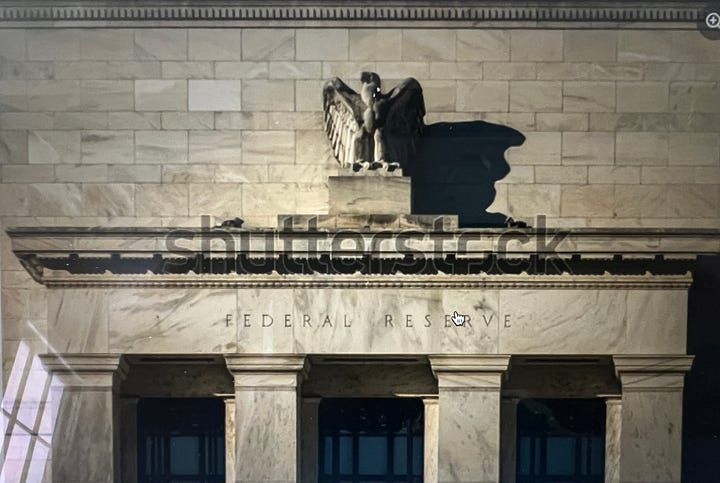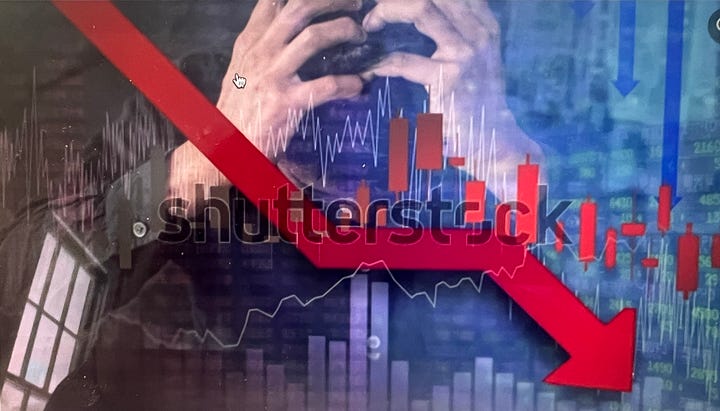Fixing The Fed – Part 1
My original plan was to add one more post in the “On Tariffs and Trade” series, but over the weekend and then especially on Monday President Trump’s escalating feud with Federal Reserve Chairman Jerome Powell has suddenly taken center stage. As a headline in yesterdays The Wall Street Journal online noted, “Dow Drops 972 Points, Dollar Slides as Trump Renews Fed Attacks”.
I agree with the President that the Fed has played a primary role in creating many of our current problems, that it has not been held accountable for its mistakes, and that it is deeply in need of reform. But I disagree with the President on what exactly those problems are and how they should be fixed.
President Trump is frustrated with the Fed for failing to ease monetary policy to help markets adjust to his new tariff proposals. His threatened solution is to make the Fed more accountable to the President so that he can push for lower interest rates. But, paradoxically, market interest rates have been moving up as fears of recession and a return to easy monetary policies have grown. In an upcoming post, I’ll devote more time to the range of factors behind this unusual bond market reaction, but for now let’s focus on the Fed.
Over the past few decades, the Fed has effectively acted like a monetary drug dealer who has pushed our economy into an addiction to its easy money policies. As I pointed out in the “On Tariffs and Trade – Part 1” post, excessively easy money has pushed the stock market and other assets to all time highs, which has made the markets especially vulnerable to potential economic disruptions, such as the tariffs. The solution is not to further concentrate interest rate policy in the hands of the President, but is rather to go in the opposite direction and find ways to curtail the Fed’s ability to try and fine tune economic outcomes.
In effect, in spite of the great success of our generally free market system, we have allowed way too much leeway for centrally planned monetary policy to try and manufacture economic outcomes, with results that have been disastrous but not well understood. In this post, we’ll focus on understanding the Fed and its long history of failed policy making, including its responsibility for the three worst economic periods of the past century. In future posts, I’ll zero in on how the Fed has pushed our economy into the easy money addiction that has made the markets so vulnerable to current conditions, and then further discuss appropriate policy responses and reform objectives for the Fed.


The following is an excerpt from my book, 2008: What Really Happened – Understanding The Great Financial Crisis.
The Fed in Theory and Practice
The Federal Open Market Committee (FOMC) is a small group of policymakers within the Federal Reserve that meets several times a year to set a target for the federal funds rate, which is the interest rate on overnight loans between banks. While interest rates on these loans are nominally determined by the market, in reality the Fed engages in what are called “open market activities” to push the federal funds rate toward the target established by the FOMC.
Through the open-market purchases of government securities, the Fed either increases the money supply, which lowers interest rates, or reduces the money supply, which raises interest rates. The FOMC operates with a dual mandate: it is supposed to consider both the inflationary consequences of pushing too much money into the system and the potential drag on economic output (and therefore on employment) if it contracts the money supply too quickly.
From a more practical standpoint, if the Fed wants to “juice” things a bit, it electronically prints money and injects that money into the system through bond purchases, which lowers the cost of borrowing and spurs economic activity. If the Fed is concerned that inflation might be moving into dangerous territory, it contracts the money supply, which raises interest rates and causes economic activity to diminish. Or, to expand slightly on a famous analogy offered by the former Fed chairman William McChesney Martin: When the economy is dormant and the Fed senses the need to get the party going, it spikes the economic punchbowl with a shot of “moola.” Then, when it begins to worry that the party might be on the verge of spinning out of control, the Fed’s job is to remove the punchbowl, thereby saving the partygoers from a vicious hangover.
At least that is how it’s all supposed to work in theory—and there have been times when the Fed’s actions have seemed to smooth out economic outcomes, at least for a while. During the first fifteen years or so of his tenure as Federal Reserve chairman, Alan Greenspan was dubbed “the Maestro” for his seemingly uncanny ability to assist the remarkable stretch of sustained growth from the early 1980s through the ’90s. (As I’ll show in a future post, while widely admired at the time, this period in fact ushered in the easy money addiction at the heart of our current withdrawal pains.)
At other times, however, the Fed’s policy moves have not been so widely admired—in fact, just the opposite. It is now generally accepted by economists of all political stripes that the Fed’s misguided policies caused the Great Inflation of the 1970s. Furthermore, it is also widely accepted among economists that misguided Fed policies were a primary cause of the Great Depression of the 1930s—in a speech given in honor of Milton Friedman’s ninetieth birthday, the former Fed chair Ben Bernanke stated, “Regarding the Great Depression. You’re right, we did it. We’re very sorry. But thanks to you we won’t do it again.”
The Fed’s singular ability to exert such an extraordinary and systemic impact on the economy stems from its control of short-term interest rates, which gives it the ability to determine the price of money. In an advanced, credit-driven economy, the Fed has the power to influence everything from auto sales in Alaska to housing prices in Honolulu to stock prices on Wall Street. In a dynamic and competitive economy like ours, no private institution has the ability to exert anywhere near this type of systemic influence. For example, Walmart was far and away the largest company in America in 2020, with revenues nearly 50% above its nearest rival on the Fortune 500 list. But Walmart’s $570 billion of revenue accounted for less than three cents out of every dollar of national economic output. Stated simply, nothing compares to the Fed’s ability to impact all sectors of the economy in all regions of the country simultaneously.
So much power emanating from a tiny group of people setting interest rates at the FOMC is a bit reminiscent of when the genie in the Disney film Aladdin emerges from his lamp and swells to seemingly universal proportions as his voice booms, “PHENOMENAL COSMIC POWERS”—only to then recede back into the lamp as he squeaks, “itty bitty living space!”
To summarize: the Fed has an enormous and unmatched ability to influence economic activity, and even though it acts with the good intention of smoothing out economic cycles, on multiple occasions its practices have produced a very different result. Or, to be a bit more blunt about it, the Fed played a primary role in causing the two worst economic decades of the twentieth century (the 1930s and 1970s), and as I have shown in my book, the Fed also played a leading role in causing the housing bubble that led to the Great Financial Crisis.
- Todd, April 22, 2025
If you found this helpful, please recommend it to at least one other person.
Subscriptions are currently FREE – if you’re not already a subscriber, sign up below.
If you’d like to learn more, visit my website: toddsheetswriter.com
To purchase a copy of my book, 2008: What Really Happened, go to Amazon.com, barnesandnoble.com, Bookshop.org, or encounterbooks.com.


